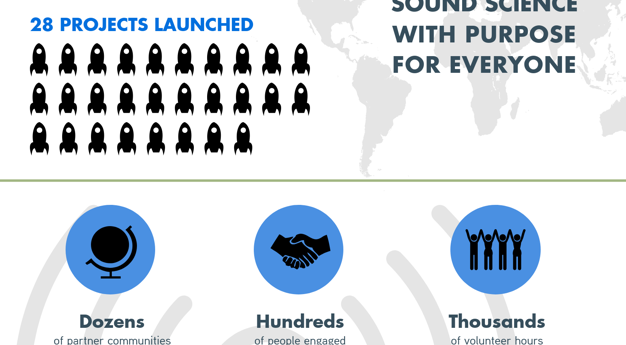Thriving Earth Exchange emerged from a bold vision to better leverage science to benefit humanity through a more direct partnership between scientists and communities. Five years and more than 80 projects in, the phase of quiet experimentation is over. Thriving Earth Exchange, and the approach we call community science, has evolved, matured, and proved its value—not only for communities but for the science, as well.
 The accomplishments of this community-centered approach have reverberated in ways large and small across our nation and indeed the world. Our work has brought tangible benefits to communities facing enduring and impactful dilemmas, for example, rising waters inundating a way of life, heat and droughts threatening health and safety, or the scourge of pollution among the most vulnerable. By working as equal partners, community members and Earth and space scientists have forged innovative solutions to vexing challenges, informed evidence-based decisions and created the foundations for long-term, far-reaching change.
The accomplishments of this community-centered approach have reverberated in ways large and small across our nation and indeed the world. Our work has brought tangible benefits to communities facing enduring and impactful dilemmas, for example, rising waters inundating a way of life, heat and droughts threatening health and safety, or the scourge of pollution among the most vulnerable. By working as equal partners, community members and Earth and space scientists have forged innovative solutions to vexing challenges, informed evidence-based decisions and created the foundations for long-term, far-reaching change.
This work has advanced AGU’s mission—to promote discovery in Earth and space science for the benefit of humanity—while contributing to a broader movement for community science. Our iterative, reflective process has established a method that works well and established Thriving Earth Exchange as a key leader in community science.
On track to easily meet our initial set of goals, it is time for AGU and Thriving Earth Exchange to think about what comes next: scaling and growing. That means reaching out and communicating about community science, bringing more partners into the fold, engaging more volunteers, and expanding our perspective on what’s possible. As we recognize AGU’s Centennial, Thriving Earth Exchange is both a celebration of science and much more—a bold vision, drawn from expertise and experience, for how science can help us build a better world.
Thriving Earth Exchange Projects – 2018 Snapshot
In 2018, we wrapped up 10 projects and launched more than double that number, working with communities to tackle a range of issues from to resilience to infrastructure to environmental justice.
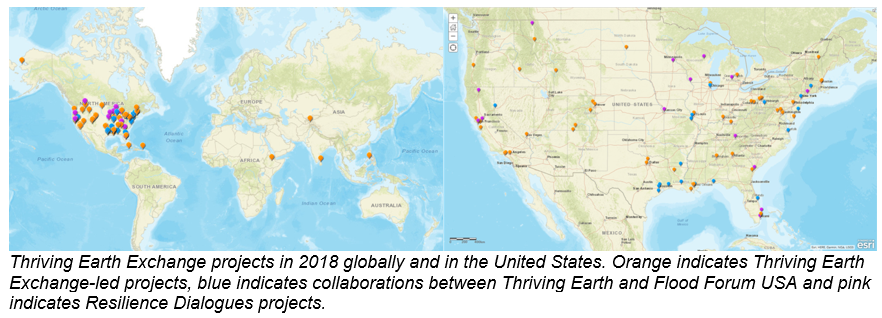
Completed in 2018
- Integrating Sea Level Rise, Riverine and Flood Models in Marin County, Calif.
- Developing an Environmental Impact Monitoring Plan in Evanston, Ill.
- Creating Community Through Neighborhood Environment Monitoring in New Orleans, La.
- Synthesizing Climate Vulnerability Assessments in Chelsea, Mass.
- Mapping Heat Vulnerability in Missoula, Mont.
- Assessing Drought Risk and Vulnerability in Las Vegas, Nev.
- Remediating Groundwater Dioxane to Mitigate Marl Pond Degradation in Colebrook, N.H.
- Designing a Makerspace to Support Innovation in Economic Diversity Opportunities in Farmington, N.M.
- Assessing Flooding and Hydrodynamics for Community Revitalization in Connellsville, Penn.
- Assessing Flooding and Hydrodynamics for Flood Prevention and Mitigation in Virginia Beach, Va.
Launched in 2018
- Incentivizing Clean Industry in Birmingham, Ala.
- Sustaining Vulnerable Infrastructure in Shishmaref, Alaska
- Integrating Sea Level Rise, Riverine and Flood Models in Marin County, Calif. (Phase 2)
- Updating a Greenhouse Gas Inventory in Durango, Colo.
- Communicating and Acting on Climate Change in Hallandale Beach, Fla.
- Assessing Flooding and Hydrodynamics for Community Preparedness and Revitalization in Pensacola, Fla.
- Standardizing Greenhouse Gas Inventory Outputs for Decision-Making in Atlanta, Ga.
- Assessing Flooding and Hydrodynamics for Community Revitalization in Cicero & Berwyn, Ill.
- Recycling Food and Animal Waste for Social Good in Montego Bay, Jamaica
- Documenting the Loss of Sacred Tribal Lands to Preserve Cultural Identity and Heritage in Louisiana and Terrebonne and Lafourche Parishes
- Assessing Flooding and Hydrodynamics for Community Preparedness and Revitalization in Lafayette, La.
- Assessing Flooding and Hydrodynamics for Improved Stormwater Management in Natchitoches, La.
- Understanding Impact of Municipal Water Sources on Urban Farming in New Orleans, La.
- Measuring and Monitoring the Effects of Greening on the Urban Heat Island Effect, Water Uptake, and Social Challenges in New Orleans, La.
- Modeling Environmental Health Impacts of I-10 to Engage Residents and Decision Makers in New Orleans, La.
- Assessing Flooding and Hydrodynamics for Community Preparedness and Revitalization in New Orleans, La.
- Designing a Green Roof for Community Re-vitalization and Empowerment in Flint, Mich.
- Assessing Future Flood Risk for Sustainable Solutions in Brazoria County, Texas
- Evaluating Urban Stormwater Drainage to Develop Flood-Resilient Neighborhoods in Northeast Houston, Texas
- Assessing Flooding and Hydrodynamics for Community Revitalization and Preparedness in Port Arthur, Texas
- Assessing Wetland Capacity to Provide Flood Control Benefits in Staten Island, New York
- Planning Climate Resilient Stormwater Infrastructure for a Growing Region in Northern Virginia
- Resilience Dialogues in Anchorage, Alaska; Nashua, N.H.; Carlisle, Penn.; Beaumont, Texas; Bradford County, Fla.; and Winters, Calif.
Programs & Partners
When Thriving Earth Exchange launched, we realized very quickly how crucial it would be to cultivate productive partnerships with organizations whose missions and activities synergize with our own. We are extremely grateful to our growing network of partners and amazed at what we have accomplished together. These partnerships, along with broader programs that advance specific aspects of the community science method, form the connective tissue that inform individual projects and enable them to thrive.
Thriving Earth Exchange Volunteer Scientist Network
Matching vetted scientists to specific community needs is a rate-limiting step in the Thriving Earth Exchange process. At the same time, we have often found ourselves contacted by scientists interested in contributing to the program at times when we had no opportunities to offer them. To address these gaps, in 2018 we launched the Thriving Earth Exchange Volunteer Scientist Network, which allows scientists to detail their areas of expertise and interest in working with a community. By having this information ahead of time, we are able to contact interested individuals as soon as a suitable project is launched.
Resilience Dialogues 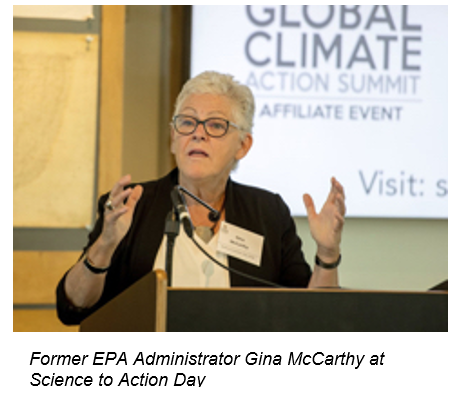
Resilience Dialogues facilitates online conversations between technical experts and community leaders focused on local priorities related to climate resilience. After two years developing the model and using it to engage 15 communities, Thriving Earth Exchange formally transferred leadership of program to the American Society for Adaptation Professionals in 2018. We remain engaged in managing implementation support for alumni communities and maintaining the online Resilience Dialogues platform on AGU Connect.
AGU Science to Action Community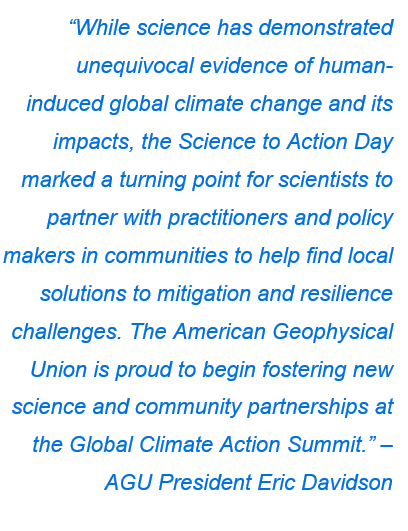
Thriving Earth Exchange has played an active role in advancing efforts to bring together scientists and decision makers as part of AGU’s Science to Action community. This community, which emerged organically over the course of the last few years, has outlined frameworks for “coproduction” between scientists and decision makers, documented the increased interest in coproduction among AGU members in recent years and created a hub for discussing and advancing society-engaged work at AGU’s Fall Meeting.
Science to Action Day
On September 11, 2018, just before the Global Climate Action Summit, AGU and the Thriving Earth Exchange partnered with the California Office of Planning and Research to hold Science to Action Day, a one-day event to focus on how science can continue to support ambitious action on climate change. The event brought together researchers, businesses, subnational governments and other stakeholders undertaking climate action to identify opportunities for scientific partnerships to support subnational climate actions. Outcomes included a declaration outlining a statement of principles and concrete proposals for next steps.
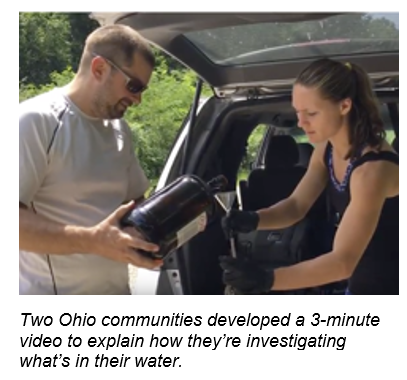 GeoPolicy Connect Cohort
GeoPolicy Connect Cohort
Our cohort approach enables communities with similar issues in a similar geographic locale to share resources as they engage in a community science project. In late 2017, we launched the GeoPolicy Connect cohort, a group of projects focused on issues related to hydraulic fracturing. Community partners in Barnesville, Ohio and nearby Cambridge, Ohio have been particularly successful in sharing resources and efforts. They held a joint community meeting, they conducted a tour with Dennis Kucinich, developed a short video, and collaboratively submitted a grant proposal to the National Institutes of Health. Although the grant proposal was unsuccessful, the synergies that arose in this effort are a testament to the power of a cohort approach to strengthen individual projects.
NASA DEVELOP
This year Thriving Earth Exchange linked up with NASA DEVELOP, a NASA program focused on bridging the gap between NASA Earth science and society, to extend a NASA DEVELOP urban development project in New Orleans to benefit ongoing New Orleans-area Thriving Earth projects. The partnership connected Thriving Earth project participants with DEVELOP’s work and its community partner, Groundwork New Orleans, sparking further engagement. The exchange also helped NASA identify focus areas for a subsequent DEVELOP project.
Flood Forum USA
A partnership with Flood Forum led to numerous new projects focused on community-led efforts to model and address flood risks. The fruitful collaboration has matched communities with technical expertise to give visibility to the stories of individuals and communities harmed by flooding and inform concrete actions for flood prevention.
Sister Cities International
Connecting with Sister Cities International opened Thriving Earth Exchange to a wide array of domestic and international project possibilities for a project launch workshop held in December 2018. In particular, the partnership has been instrumental in advancing our goal of launching nine international projects by 2019.
Outreach
Learning is a huge part of our process and at the heart of our successes. Often, we find the best way to learn is by communicating about our work with others, especially those with perspectives that may be different from our own. This year we have had the opportunity to communicate with an incredible range of organizations and individuals—and learned an incredible amount in the process.
Blogs
This year’s most popular blogs included:
- It’s Time to Shake Science’s Superiority Complex
- Ocean City Flooding Making a Splash in the News
- Recipes for a ‘Potluck’ Model of Science Engagement
- Beyond the Loading Dock
- What’s the ticket to a successful community meeting? Make it personal.
Multimedia
- Thriving Earth Exchange was featured in the Infinite Earth Radio podcast by host Kif Scheuer as part of the podcast’s Adaptation and Livable Communities Series.
- A video developed by student volunteer Meagan Cantwell highlights the role of Thriving Earth Exchange within the AGU context to support Earth and space science for the advancement of humanity through community science engagement.
- Thriving Earth Exchange partnered with the American Geosciences Institute for a webinar on Geoscience for Community Priorities. Thriving Earth Exchange Director Raj Pandya discussed characteristics of community science, common obstacles for both geoscientists and communities, and steps that geoscientists and communities can take to collaborate with each other on community science. Thriving Earth Exchange Senior Specialist Natasha Udu-gama discussed best practices in community science and how Thriving Earth Exchange is connecting pro bono geoscientists and communities.
In the News
- Thriving Earth Director Raj Pandya and co-authors of an article in Issues in Science and Technology Magazine spoke on human adaptation to climate change in a public broadcast by C-SPAN.
- The plight of Thriving Earth community partners in Brandywine, Md. was highlighted in an in-depth article in Wired.
- Thriving Earth Project Manager Sarah Wilkins was featured in a Detroit Public TV segment on what the water crisis in Flint, Mich. reveals about water in the rest of America and the world.
- In AGU’s magazine Eos, Raj Pandya reflected on chairing the committee that wrote a 2018 report from the National Academies of Sciences, Engineering, and Medicine offering guidance for how citizen science can support both educational and research goals.
On the Road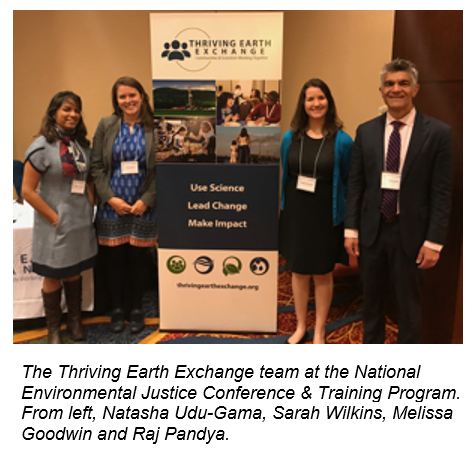
We were honored to participate in numerous conferences and events this year, many of which tackled tough questions at the intersections of science, society and justice.
- AAAS Annual Meeting
- Climate Changed
- National Environmental Justice Conference & Training Program
- AAAS Symposium on Community Driven Citizen Science for Health and the Environment
- Earth Educators Rendezvous
- Remodeling Science: An Opportunity for UC Davis
- Science to Action Day
- Inclusive Sci Comm Symposium
- Coastlines and People (CoPe) scoping workshop
- Society of Environmental Journalists Annual Conference
- AGU’s Fall Meeting
Operations
The forward-thinking and creative individuals who comprise our staff and Advisory Board are crucial to advancing the Thriving Earth Exchange mission. We want to express our sincere thanks to all of the staff and Board members who have devoted their time and expertise to our community science work over the years. In 2018, we welcomed new Board members Rick Murnane and Jeff Zonis, as well as staff members Zack Valdez and Shahan Haq.
Looking Ahead
We are thrilled to embark on an exciting line-up of projects, partnerships and programs in 2019. Here’s a preview of what’s on deck:
Events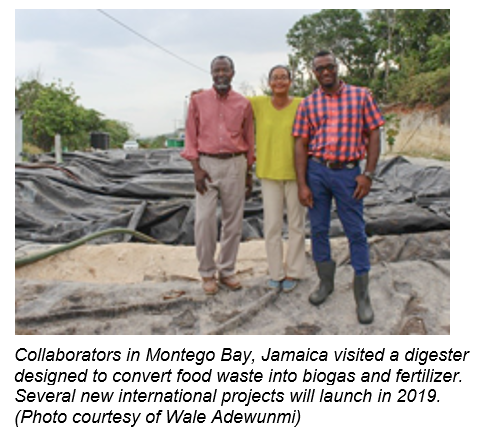
- National Council for Science and the Environment 2019 Annual Conference
- AAAS Annual Meeting
- Citizen Science Association Meeting
- Geoscience and Society Summit
- Society for Applied Anthropology Annual Meeting
- National Adaptation Forum
- Caribbean Sister Cities Summit
Programs and Projects
- Continuing to build our Volunteer Scientist Network
- Increasing our international reach with the launch of new projects in St. Lucia, Haiti, Democratic Republic of Congo, Dominican Republic and Guyana, among others
- Cultivation of a “network of networks” that will link community science efforts across multiple disciplines and scientific societies to build and share community science tools and solutions
- Establishment of a scaling model in which partners and volunteers play a larger role in designing, scoping, matching, and sharing community science projects

